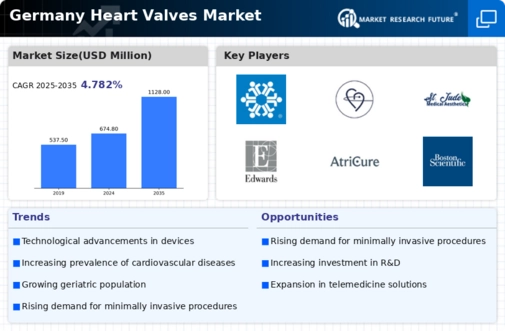Rising Cardiovascular Diseases
The increasing prevalence of cardiovascular diseases in Germany is a primary driver for the heart valves market. According to recent health statistics, cardiovascular diseases account for approximately 40% of all deaths in the country. This alarming figure underscores the urgent need for effective treatment options, including heart valve replacements and repairs. As the population ages, the incidence of heart-related ailments is expected to rise, further propelling the demand for heart valves. The heart valves market is likely to experience substantial growth as healthcare providers seek innovative solutions to address these challenges. Moreover, advancements in surgical techniques and minimally invasive procedures are anticipated to enhance patient outcomes, thereby increasing the adoption of heart valve interventions across various healthcare settings.
Growing Awareness and Education
The growing awareness of heart health among the German population is a significant driver for the heart valves market. Public health campaigns and educational initiatives have increased knowledge about cardiovascular diseases and the importance of early detection and treatment. As individuals become more informed about the risks associated with heart conditions, they are more likely to seek medical advice and intervention. This heightened awareness is expected to lead to an increase in diagnostic procedures and subsequent heart valve treatments. The heart valves market is likely to see a rise in demand as patients actively pursue options for managing their heart health. Furthermore, healthcare providers are increasingly focusing on patient education, which may enhance compliance with treatment protocols and improve overall outcomes.
Increased Healthcare Expenditure
Germany's commitment to healthcare spending significantly influences the heart valves market. The country allocates a substantial portion of its GDP to healthcare, with expenditures reaching approximately 11.7% in recent years. This financial investment facilitates access to advanced medical technologies and treatments, including heart valve interventions. As healthcare budgets expand, hospitals and clinics are more likely to invest in state-of-the-art heart valve solutions, thereby driving market growth. The heart valves market stands to benefit from this trend, as increased funding allows for the procurement of innovative devices and the implementation of comprehensive treatment protocols. Additionally, the emphasis on preventive care and early intervention may further stimulate demand for heart valve procedures, contributing to a more robust market landscape.
Supportive Regulatory Environment
The regulatory environment in Germany is conducive to the growth of the heart valves market. The European Medicines Agency (EMA) and the Federal Institute for Drugs and Medical Devices (BfArM) play pivotal roles in ensuring the safety and efficacy of medical devices, including heart valves. Streamlined approval processes and supportive policies encourage innovation and the introduction of new products into the market. This regulatory framework fosters a competitive landscape, allowing manufacturers to bring advanced heart valve technologies to healthcare providers more efficiently. As a result, the heart valves market is likely to experience accelerated growth, driven by the availability of cutting-edge solutions that meet the evolving needs of patients and healthcare professionals alike.
Technological Innovations in Valve Design
Technological innovations play a crucial role in shaping the heart valves market. Recent advancements in materials science and engineering have led to the development of biocompatible and durable heart valves, which are essential for improving patient outcomes. For instance, the introduction of transcatheter aortic valve replacement (TAVR) has revolutionized treatment options for patients with aortic stenosis, particularly among those who are high-risk surgical candidates. The heart valves market in Germany is witnessing a surge in demand for these innovative products, as they offer less invasive alternatives to traditional surgical methods. Furthermore, ongoing research and development efforts are likely to yield even more sophisticated valve designs, potentially expanding the market and enhancing the quality of care for patients suffering from heart conditions.



















Leave a Comment